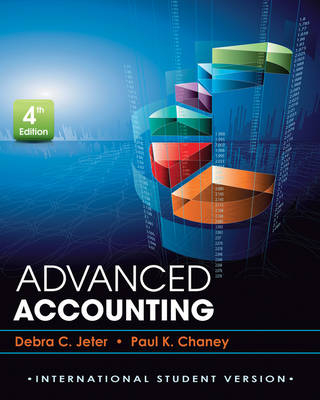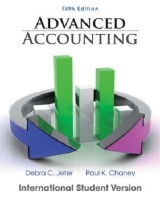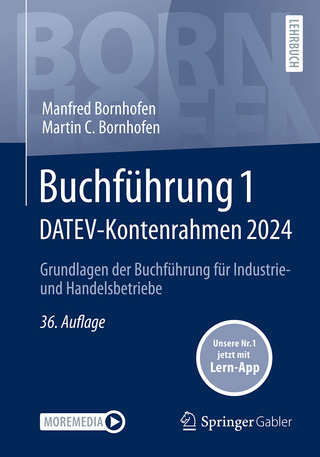
Advanced Accounting
John Wiley & Sons Ltd (Verlag)
978-0-470-55308-4 (ISBN)
- Titel ist leider vergriffen;
keine Neuauflage - Artikel merken
Designed for a senior level course in advanced accounting, this text delivers a balanced and detailed approach to the conceptual and technical aspects of advanced accounting. Reflective of the current state of the international accounting landscape, this new edition discusses the upcoming globalization of accounting standards with frequent references to the FASB's new Codification system and with a "compare and contrast" method for explaining the differences between U.S. GAAP and IFRS. In addition, Advanced Accounting includes comprehensive coverage of all three methods of consolidated financial reporting (cost, partial equity, complete equity). Authored with both the student and teacher in mind, margin icons and labels distinguish all three methods and other pedagogical features.
Debra Jeter is an Associate Professor of Management in the Owen Graduate School of Management at Vanderbilt University. She received her Ph.D. in accounting from Vanderbilt University. Dr. Jeter has published articles in The Accounting Review, the Journal of Accounting and Economics, Auditing: A Journal of Practice and Theory, Contemporary Accounting research, and Accounting Horizons, as well as in popular magazines including Working Woman and Savvy. She has co-authored on previous book, "Managerial Cost Accounting: Planning and Control," and has written chapters in others. She has taught at both the graduate and undergraduate levels and is currently teaching financial accounting to masters' level students.
PART I ACCOUNTING FOR MERGERS AND AQUISITIONS 1 - INTRODUCTION TO BUSINESS COMBINATIONS AND THE CONCEPTUAL FRAMEWORK 1 Learning Objectives, 1 Nature of the Combination, 5 Business Combinations: Why? Why not?, 7 Business Combinations: Historical Perspective, 10 Terminology and Types of Combinations, 14 Takeover Premiums, 17 Avoiding the Pitfalls before the Deal, 18 Determining Price and Method of Payment in Business Combinations, 20 Alternative Concepts of Consolidated Financial Statements, 24 Authors' View, 29 FASB's Conceptual Framework, 29 Summary, 35 Questions, 37 Exercises, 37 2 - ACCOUNTING FOR BUSINESS COMBINATIONS 40 Learning Objectives, 40 Historical Perspective on Business Combinations, 40 Pro Forma Statements and Disclosure Requirement, 49 Explanation and Illustration of Acquisition Accounting, 51 Contingent Consideration in an Acquisition, 56 Leveraged Buyouts, 59 Summary, 62 Appendix A: Deferred Taxes in Business Combinations, 64 Appendix B: Did Firms Prefer Pooling, and Why?, 65 Questions, 68 Exercises, 69 Problems, 77 3 - CONSOLIDATED FINANCIAL STATEMENTS--DATE OF ACQUISITION 82 Learning Objectives, 82 Definitions of Subsidiary and Control, 84 Requirements for the Inclusion of Subsidiaries in the Consolidated Financial Statements, 87 Reasons for Subsidiary Companies, 88 Consolidated Financial Statements, 88 Investments at the Date of Acquisition, 90 Consolidated Balance Sheets: The Use of Workpapers, 91 A Comprehensive Illustration--More Than One Subsidiary Company, 107 Limitations of Consolidated Statements, 109 Summary, 110 Appendix A: Deferred Taxes on the Date of Acquisition, 111 Appendix B: Consolidation of Variable Interest Entities, 113 Questions, 115 Exercises, 116 Problems, 120 4 - CONSOLIDATED FINANCIAL STATEMENTS AFTER ACQUISITION 128 Learning Objectives, 128 Accounting for Investments by the Cost, Partial Equity, and Complete Equity Methods, 129 Consolidated Statements after Acquisition--Cost Method, 138 Recording Investments in Subsidiaries--Equity Method (Partial or Complete), 150 Elimination of Intercompany Revenue and Expense Items, 160 Interim Acquisitions of Subsidiary Stock, 162 Consolidated Statement of Cash Flows, 174 Illustration of Preparation of a Consolidated Statement of Cash Flows: Year of Acquisition, 177 Summary, 181 Appendix A: Alternative Workpaper Format, 182 Appendix B: Deferred Tax Consequences When Affiliates File Separate Income Tax Returns--Undistributed Income, 184 Questions, 190 Exercises, 192 Problems, 199 5 - ALLOCATION AND DEPRECIATION OF DIFFERENCES BETWEEN IMPLIED AND BOOK VALUES 213 Learning Objectives, 213 Allocation of the Difference between Implied and Book Values to Assets and Liabilities of Subsidiary: Acquisition Date, 216 Effect of Allocation and Depreciation of Differences between Implied and Book Values on Consolidated Net Income: Year Subsequent to Acquisition, 222 Consolidated Statements Workpaper--Investment Recorded Using the Cost Method, 227 Cost Method Analysis of Controlling and Noncontrolling Interests in Consolidated Net Income and Retained Earnings, 236 Consolidated Statements Workpaper--Investment Recorded Using Partial Equity Method, 238 Partial Equity Method Analysis of Controlling and Noncontrolling Interests in consolidated Net Income and Retained Earnings, 246 Consolidated Statements Workpaper--Investment Recorded Using Complete Equity Method, 248 Complete Equity Method Analysis of Controlling Interest in Consolidated Net Income and Retained Earnings, 256 Additional Considerations Relating to Treatment of Difference between Implied and Book Values, 257 Push Down Accounting, 266 Summary, 272 Questions, 273 Exercises, 274 Problems, 280 6 - ELIMINATION OF UNREALIZED PROFIT ON INTERCOMPANY SALES OF INVENTORY 297 Learning Objectives, 297 Effects of Intercompany Sales of Merchandise on the Determination of Consolidated Balances, 298 Cost Method: Consolidated Statements Workpaper--Upstream Sales, 308 Cost Method--Analysis of Consolidated Net Income and Consolidated Retained Earnings, 314 Consolidated Statements Workpaper--Partial Equity Method, 317 Partial Equity Method--Analysis of Consolidated Net Income and Consolidated Retained Earnings, 321 Consolidated Statements Workpaper--Complete Equity Method, 322 Complete Equity Method--Analysis of Consolidated Net Income and Consolidated Retained Earnings, 327 Summary of Workpaper Entries Relating to Intercompany Sales of Inventory, 327 Intercompany Profit Prior to Parent--Subsidiary Affiliation, 328 Summary, 329 Questions, 330 Exercises, 330 Problems, 333 7 - ELIMINATION OF UNREALIZED GAINS OR LOSSES ON INTERCOMPANY SALES OF PROPERTY AND EQUIPMENT 345 Learning objectives, 345 Intercompany Sales of Land (Nondepreciable Property), 346 Intercompany Sales of Depreciable Property (Machinery, Equipment, and Buildings), 349 Consolidated Statements Workpaper--Cost and Partial Equity Methods, 357 Calculation of Consolidated Net Income and Consolidated Retained Earnings, 366 Consolidated Statements Workpaper--Complete Equity Method, 369 Calculation and Allocation of Consolidated Net Income; Consolidated Retained Earnings: Complete Equity Method, 376 Summary of Workpaper Entries Relating to Intercompany Sales of Equipment, 376 Intercompany Interest, Rents, and Service Fees, 376 Summary, 380 Questions, 381 Exercises, 381 Problems, 385 8 - CHANGES IN OWNERSHIP INTEREST 396 Learning Objectives, 396 Parent Acquires Subsidiary Stock Through Several Open-Market Purchases--Cost Method, 398 Parent Sells Subsidiary Stock Investment on the Open Market, 402 9 - INTERCOMPANY BOND HOLDINGS AND MISCELLANEOUS TOPICS--CONSOLIDATED FINANCIAL STATEMENTS 404 Learning Objectives, 404 Intercompany Bond Holdings, 405 Accounting for Bonds--A Review, 406 Constructive Gain or Loss on Intercompany Bond Holdings, 407 Accounting for Intercompany Bonds Illustrated, 410 Book Entry Related to Bond Investment, 411 Interim Purchase of Intercompany Bonds, 427 Notes Receivable Discounted, 428 Stock Dividends issued by a Subsidiary Company, 430 Dividends From Preacquisition Earnings, 434 Subsidiary with Both Preferred and Common Stock Outstanding, 435 Consolidating a Subsidiary with Preferred Stock Outstanding, 438 Summary, 449 Questions, 450 Exercises, 451 Problems, 455 10 - INSOLVENCY--LIQUIDATION AND REORGANIZATION 465 Learning Objectives, 465 Contractual Agreements, 466 Bankruptcy, 467 Liquidation (Chapter 7), 470 Reorganization under the Reform Act (Chapter 11), 471 Trustee Accounting and Reporting, 482 Realization and Liquidation Account, 485 Summary, 488 Questions, 489 Exercises, 490 Problems, 494 PART II ACCOUNTING IN THE INTERNATIONAL MARKETPLACE 11 - INTERNATIONAL ACCOUNTING AND THE GLOBAL ECONOMY 501 Learning Objectives, 501 The Increasing Importance of International Accounting Standards, 501 Harmonization of Worldwide Accounting Standards, 505 Comparative Accounting Models, 508 Classification of International Accounting Models, 514 International Reporting Issues, 516 American Depository Receipts (ADRs): An Overview, 523 Summary, 526 Appendix: Reconciliation to U.S. GAAP--GlaxoSmithKline 2005, 527 Questions, 534 Exercises, 535 Problems, 535 12 - ACCOUNTING FOR FOREIGN CURRENCY TRANSACTIONS AND HEDGING FOREIGN EXCHANGE RISK 541 Learning Objectives, 541 Exchange Rates--Means of Translation, 543 Measured versus Denominated, 546 Foreign Currency Transactions, 546 Using Forward Contracts as a Hedge, 557 Summary, 574 Questions, 575 Exercises, 576 Problems, 584 13 - TRANSLATION OF FINANCIAL STATEMENTS OF FOREIGN AFFILIATES 591 Learning Objectives, 591 Accounting for Operations in Foreign Countries, 592 Translating Financial Statements of Foreign Affiliates, 593 Objectives of Translation--SFAS No. 52, 594 Translation Methods, 595 Identifying the Functional Currency, 597 Translation of Foreign Currency Financial Statements, 598 Translation of Foreign Financial Statements Illustrated, 602 Financial Statement Disclosure, 611 Historical Developments of Accounting Standards, 613 Summary, 614 Appendix: Accounting for a Foreign Affiliate and Preparation of Consolidated Statements Workpaper Illustrated, 615 Questions, 622 Exercises, 623 Problems, 629 14 - REPORTING FOR SEGMENTS AND FOR INTERIM FINANCIAL PERIODS 639 Learning Objectives, 639 Need for Disaggregated Financial Data, 640 Standards of Financial Accounting and Reporting, 640 International Accounting Standards Board (IASB) Position on Segment Reporting, 651 Interim Financial Reporting, 653 Summary, 660 Questions, 665 Exercises, 666 Problems, 670 PART III PARTNERSHIP ACCOUNTING 15 - PARTNERSHIPS: FORMATION, OPERATION, AND OWNERSHIP CHANGES 675 Learning Objectives, 675 Partnership Defined, 677 Reasons for Forming a Partnership, 678 Characteristics of a Partnership, 679 Partnership Agreement, 681 Accounting for a Partnership, 683 Special Problems in Allocation of Income and Loss, 691 Financial Statement Presentation, 693 Changes in the Ownership of the Partnership, 694 Section A: Admission of a New Partner, 696 Section B: Withdrawal of a Partner, 703 Summary, 707 Questions, 708 Exercises, 709 Problems, 715 16 - PARTNERSHIP LIQUIDATION 723 Learning Objectives, 723 Steps in the Liquidation Process, 724 Priorities of Partnership and Personal Creditors, 726 Simple Liquidation Illustrated, 728 Installment Liquidation, 730 Incorporation of a Partnership, 739 Summary, 741 Questions, 742 Exercises, 742 Problems, 748 PART IV FUND AND NONPROFIT ACCOUNTING 17 - INTRODUCTION TO FUND ACCOUNTING (online only) Classifications of Nonbusiness Organizations Distinctions between Nonbusiness Organizations and Profit-Oriented Enterprises Financial Accounting and Reporting Standards for Nonbusiness Organizations Fund Accounting Reporting Inventory and Prepayments in the Financial Statements Summary Appendix: City of Atlanta Partial Financial Statements Questions Exercises Problems 18 - INTRODUCTION TO ACCOUNTING FOR STATE AND LOCAL GOVERNMENTAL UNITS (online only) Learning Objectives The History of Generally Accepted Governmental Accounting Standards The Structure of Governmental Accounting Governmental Fund Entities Proprietary Funds Fiduciary Funds Capital Assets and Long-Term Debt External Reporting Requirements (GASB STATEMENT No. 34) Government Fund-Based Reporting Government-Wide Reporting Management's Discussion and Analysis (MD&A) Special Assessments Interfund Activity Summary Appendix A: Government-Wide Financial Statements City of Atlanta Questions Analyzing Financial Statements (AFS) Exercises Problems 19 - ACCOUNTING FOR NONGOVERNMENT NONBUSINESS ORGANIZATIONS: COLLEGES AND UNIVERSITIES, HOSPITALS AND OTHER HEALTH CARE ORGANIZATIONS (online only) Learning Objectives Sources of Generally Accepted Accounting Standards for Nongovernment Nonbusiness Organizations Fund Accounting Accrual Basis of Accounting Classification of Revenue and Expense Accounting for Current Funds Contributions Accounting for Plant Funds Accounting for Endowment Funds Accounting for Investments Accounting for Loan Funds Accounting for Agency (Custodial) Funds Accounting for Annuity and Life Income Funds Issues Relating to Colleges and Universities Issues Relating to Hospitals Summary Appendix: Sample Financial Statements for Private Educational Institutions Questions Exercises Problems Glossary Appendix Index Learning objectives
| Verlagsort | Chichester |
|---|---|
| Sprache | englisch |
| Maße | 203 x 254 mm |
| Gewicht | 1442 g |
| Einbandart | Paperback |
| Themenwelt | Wirtschaft ► Betriebswirtschaft / Management ► Rechnungswesen / Bilanzen |
| ISBN-10 | 0-470-55308-1 / 0470553081 |
| ISBN-13 | 978-0-470-55308-4 / 9780470553084 |
| Zustand | Neuware |
| Informationen gemäß Produktsicherheitsverordnung (GPSR) | |
| Haben Sie eine Frage zum Produkt? |
aus dem Bereich



